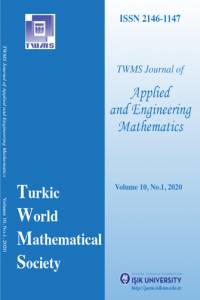A CRITICAL STUDY OF MEROMORPHIC STARLIKE FUNCTIONS
An attempt has been made to introduce a new criterion to make it possible to change meromorphic analytic function into a meromorphic starlike function of particular order. This criterion is based on a dierential operator which is dened in a punctured unit disk U. By using this criterion, one can nd easily dierent types of meromorphic starlike functions of specic order.
___
- Royster, W. C., (1963), Meromorphic starlike multivalent functions, Trans. Amer. Math. Soc., 107, pp. 300-308.
- El-Ashwah, R. M., (2009), A note on certain meromorphic p-valent functions, App. Math. Lett., 22, pp. 1756-1759.
- Cho, N. E., Kwon, O. S. and Srivastava, H. M., (2004), Inclusion and argument propertie for certain subclasses of meromorphic functions associated with a family of multiplier transformations, J. Math. Anal. Appl., 300, pp. 505-520.
- Cho, N. E., Kwon, O. S. and Srivastava, H. M., (2005), Inclusion relationships for certain subclasses of meromorphic functions associted with a family of multiplier transformations, Integral Transforms
- Special Functions, 16 (18), pp. 647-659. Aouf, M. K. and Hossen, H. M., (1993), New criteria for meromorphic p-valent starlike functions, Tsukuba J. Math., 17, pp. 481-486.
- Liu, J. L. and Owa, S., (1998), On certain meromorphic p-valent functions, Taiwanese J. Math., 2 (1), pp. 107-110.
- Liu, J. L. and Srivastava, H. M., (2004), Subclasses of meromorphicaly multivalent functions associated with certain linear operator, Math. Comput. Mode., 39 (1), pp. 35-44.
- Srivastava, H. M. and Patel, J., (2005), Applications of differential subordination to certain classes of meromorphicaly multivalent functions, J. Ineq. Pure Appl. Math., 6 (3), Art. 88, pp. 15.
- Uralegaddi, B. A. and Somanatha, C., (1991), New criteria for meromorphic starlike univalent func- tions, Bull. Austral. Math. Soc., 43, pp. 137-140.
- El-Ashwah, R. M. and Aouf, M. K., (2010), Differential subordination and superordination on p-valent meromorphic functions defined by extended multiplier transformations, European J. Pure Appl. Math., (3), pp. 1070-1085.
- Duren, P. L., (1983), Univalent functions, Grundlehren der Mathematischen Wissenschaften, Band , Springer-Verlag, New York.
- Srivastava, H. M. and Owa, S., (Eds.), (1992), Current topics in analytic function theory, World
- Scientific, Singapore. Srivastava, H. M. and Owa, S., (1987), Some characterization and distortion theorems involving fractional calculus, generalized hypergeometric functions, hadamard products, linear operators, and certain subclasses of analytic functions, Nagoya Math. J., 106, pp. 1-28.
- Cho, N. E., Kwon, O. S. and Srivastava, H. M., (2003), Inclusion and argument properties for certain subclasses of meromorphic functions associated with a family of multiplier transformations, J. Math. Anal. Appl., 286, pp. 168-176.
- Ruscheweyh, S., (1975), New criteria for univalent functions, Proc. Amer. Math. Soc., 49, pp. 109-115.
- Liu, J. L., (1996), Note on Ruscheweyh derivatives, J. Math. Anal. Appl., 199, pp. 936-940.
- Lee, S. K. and Joshi, S. B., (1999), A certain class of analytic functions defined by ruscheweyh derivatives, Comm. Korean Math. Soc., 14, pp. 234-237.
- Al-Amiri, H. S., (1980), On Ruscheweyh derivatives, Ann. Polon. Math., 38 pp. 87-94.
- Sun, Y., Kuang, W. P. and Wang, Z. G., (2012), On meromorphic starlike functions of reciprocal order α, Bull. Malays. Math. Sci. Soc., 35, pp. 469-477.
- Erdelyi, A., (1956), Asymptotic expansions, Dover publications, New York.
- ISSN: 2146-1147
- Başlangıç: 2010
- Yayıncı: Turkic World Mathematical Society
